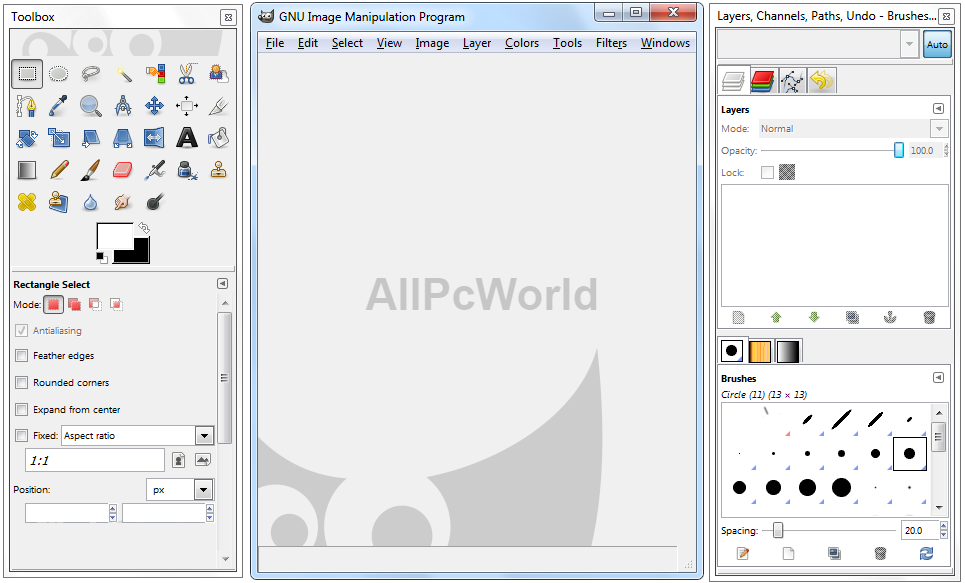


The official GIMP 2.8 DMG installer (linked above) is a stock GIMP build without any add-ons. Since the 2.8.2 version, GIMP runs on macOS/OSX natively.

If the mirrors do not work or you would rather download directly from our server, you can get the direct download here. The download links above will attempt to download GIMP from one of our trusted mirror servers. Please refer to the documentation for your Unix-like system on the installation of software. GIMP can also run on Solaris and is available for the BSD family of systems such as FreeBSD and OpenBSD. Nevertheless, note that many distros decide to pin a specific version of GIMP to their releases, whereas our flatpak will follow GIMP releases closely. It is the preferred method of installing GIMP, as the distribution maintainers take care of all the dependencies and bug fix updates. It's very likely your Unix-like system distribution already comes with a GIMP package. The flatpak build is very new and therefore may have shortcomings.
GIMP 2.8 DOWNLOAD 32 BIT INSTALL
If that is the case, ensure flatpak is installed and if clicking the link still does not prompt to install GIMP, then manually install by command line: It may not work out-of-the-box on some platforms since the flatpak technology is new.
GIMP 2.8 DOWNLOAD 32 BIT FULL
You're going to need to understand multi-layered imaging, masks and color channels to take full advantage of the tool.The flatpak link above should open your software installer and prompt you to install GIMP (available platforms: i386, x86-64, ARM and AArch64). The best thing about it is that its powerful and its free.

When the user paints this way, the output color slowly changes.Ĭons: Advanced features require knowledge of graphic arts and advanced editing techniques to take full advantage of.Ĭonclusion: GIMP is an advanced image editing tool on par with Photoshop and other expensive, best of class graphic editing tools. Gradients can also be integrated into tools such as the brush tool. You apply a gradient to the surface of an image using GIMP's color modes. GIMP does color blending through its blend tool. CMYK, LAB and HSV (hue, saturation, value) are supported this way. Other color spaces are supported using decomposition where each channel of the new color space becomes a black and white image. Colors in GIMP can also be selected using hexadecimal color codes as used in HTML color selection and it has native support for indexed color and RGB color spaces. The built-in color choosers include RGB/HSV selector or scales, water-color selector, CMYK selector and a color-wheel selector. GIMP has several ways of selecting colors including palettes, color choosers and using an eyedropper tool to select a color on the canvas. The fourth channel that may be part of a layer is the alpha channel (or layer mask), this channel measures opacity where a whole or part of an image can be completely visible, partially visible or invisible. Color sub-layers look like slightly different gray images, but when put together they make a complete image. In an RGB image there are normally 3 or 4 channels, consisting of a red, green and blue channel. Each layer in an image is made up of several channels. The blur and sharpen tool is a brush that blurs and sharpens sections of an image and the dodge and burn tool is a brush that makes target pixels lighter (dodges) or darker (burns).Īn image being edited in GIMP can consist of many layers. The perspective clone tool works in a similar way to the clone tool, but also allows a user to alter and correct distance changes. These use a more complex algorithm to enable a user to complete time consuming or difficult tasks, and include the clone tool that copies pixels using a brush, and the healing brush which copies pixels from an area and corrects the tone and color where it is being used. GIMP also has a selection of smart tools. Tools such as the bucket fill and blend tools are used to change large regions of space in an image and can be used to help blend images. You can use them to create new or blended pixels. It's more common tools include a paint brush, pencil, airbrush, eraser and ink tools. GIMP is the image editing tool of choice for many users, in large part due to its many editing tools. It’s a full featured, multi-platform graphics editor and its totally awesome. This is one of the reasons why I like GIMP. Many top of the line packages come with the features everyone wants, and unfortunately, with the price tag to go with it. In today's graphic intensive world, having a decent, full featured editor is a must. Create and edit graphics and digital photos with this world class open source graphic editing tool.


 0 kommentar(er)
0 kommentar(er)
